Inhibition of apoptosis prevents West Nile virus induced cell death
- PMID: 17535425
- PMCID: PMC1891299
- DOI: 10.1186/1471-2180-7-49
Inhibition of apoptosis prevents West Nile virus induced cell death
Abstract
Background: West Nile virus (WNV) infection can cause severe meningitis and encephalitis in humans. Apoptosis was recently shown to contribute to the pathogenesis of WNV encephalitis. Here, we used WNV-infected glioma cells to study WNV-replication and WNV-induced apoptosis in human brain-derived cells.
Results: T98G cells are highly permissive for lytic WNV-infection as demonstrated by the production of infectious virus titre and the development of a characteristic cytopathic effect. WNV replication decreased cell viability and induced apoptosis as indicated by the activation of the effector caspase-3, the initiator caspases-8 and -9, poly(ADP-ribose)polymerase (PARP) cleavage and the release of cytochrome c from the mitochondria. Truncation of BID indicated cross-talk between the extrinsic and intrinsic apoptotic pathways. Inhibition of the caspases-8 or -9 inhibited PARP cleavage, demonstrating that both caspases are involved in WNV-induced apoptosis. Pan-caspase inhibition prevented WNV-induced apoptosis without affecting virus replication.
Conclusion: We found that WNV infection induces cell death in the brain-derived tumour cell line T98G by apoptosis under involvement of constituents of the extrinsic as well as the intrinsic apoptotic pathways. Our results illuminate the molecular mechanism of WNV-induced neural cell death.
Figures
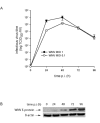
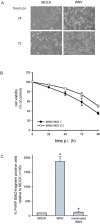
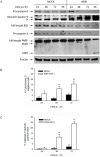
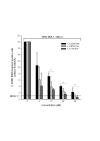
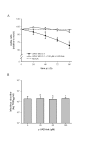
Similar articles
-
Minocycline inhibits West Nile virus replication and apoptosis in human neuronal cells.J Antimicrob Chemother. 2007 Nov;60(5):981-6. doi: 10.1093/jac/dkm307. Epub 2007 Sep 14. J Antimicrob Chemother. 2007. PMID: 17872917
-
Host cell killing by the West Nile Virus NS2B-NS3 proteolytic complex: NS3 alone is sufficient to recruit caspase-8-based apoptotic pathway.Virology. 2006 Feb 5;345(1):56-72. doi: 10.1016/j.virol.2005.08.043. Epub 2005 Oct 21. Virology. 2006. PMID: 16243374
-
The apoptotic effects of oxidative stress and antiapoptotic effects of caspase inhibitors on rat notochordal cells.Spine (Phila Pa 1976). 2007 Oct 15;32(22):2443-8. doi: 10.1097/BRS.0b013e318157395a. Spine (Phila Pa 1976). 2007. PMID: 18090083
-
Interaction of West Nile and Kunjin viruses with cellular components during morphogenesis.Curr Top Microbiol Immunol. 2002;267:353-72. doi: 10.1007/978-3-642-59403-8_17. Curr Top Microbiol Immunol. 2002. PMID: 12082997 Review. No abstract available.
-
Apoptosis and caspases regulate death and inflammation in sepsis.Nat Rev Immunol. 2006 Nov;6(11):813-22. doi: 10.1038/nri1943. Epub 2006 Oct 13. Nat Rev Immunol. 2006. PMID: 17039247 Review.
Cited by
-
Reactive Oxygen Species (ROS) Are Not a Key Determinant for Zika Virus-Induced Apoptosis in SH-SY5Y Neuroblastoma Cells.Viruses. 2021 Oct 20;13(11):2111. doi: 10.3390/v13112111. Viruses. 2021. PMID: 34834918 Free PMC article.
-
Regulation of cell survival and death during Flavivirus infections.World J Biol Chem. 2014 May 26;5(2):93-105. doi: 10.4331/wjbc.v5.i2.93. World J Biol Chem. 2014. PMID: 24921001 Free PMC article. Review.
-
Mitochondria and Mitochondrial DNA: Key Elements in the Pathogenesis and Exacerbation of the Inflammatory State Caused by COVID-19.Medicina (Kaunas). 2021 Sep 3;57(9):928. doi: 10.3390/medicina57090928. Medicina (Kaunas). 2021. PMID: 34577851 Free PMC article. Review.
-
Analysis of the Langat Virus Genome in Persistent Infection of an Ixodes scapularis Cell Line.Viruses. 2016 Sep 10;8(9):252. doi: 10.3390/v8090252. Viruses. 2016. PMID: 27626437 Free PMC article.
-
Differential Metabolic Reprogramming by Zika Virus Promotes Cell Death in Human versus Mosquito Cells.Cell Metab. 2019 May 7;29(5):1206-1216.e4. doi: 10.1016/j.cmet.2019.01.024. Epub 2019 Feb 28. Cell Metab. 2019. PMID: 30827860 Free PMC article.
References
-
- Nash D, Mostashari F, Fine A, Miller J, O'Leary D, Murray K, Huang A, Rosenberg A, Greenberg A, Sherman M, Wong S, Layton M, West Nile Outbreak Response Working Group The outbreak of West Nile virus infection in the New York City area in 1999. N Engl J Med. 2001;344:1807–1814. doi: 10.1056/NEJM200106143442401. - DOI - PubMed
Publication types
MeSH terms
Substances
LinkOut - more resources
Full Text Sources
Other Literature Sources
Research Materials

